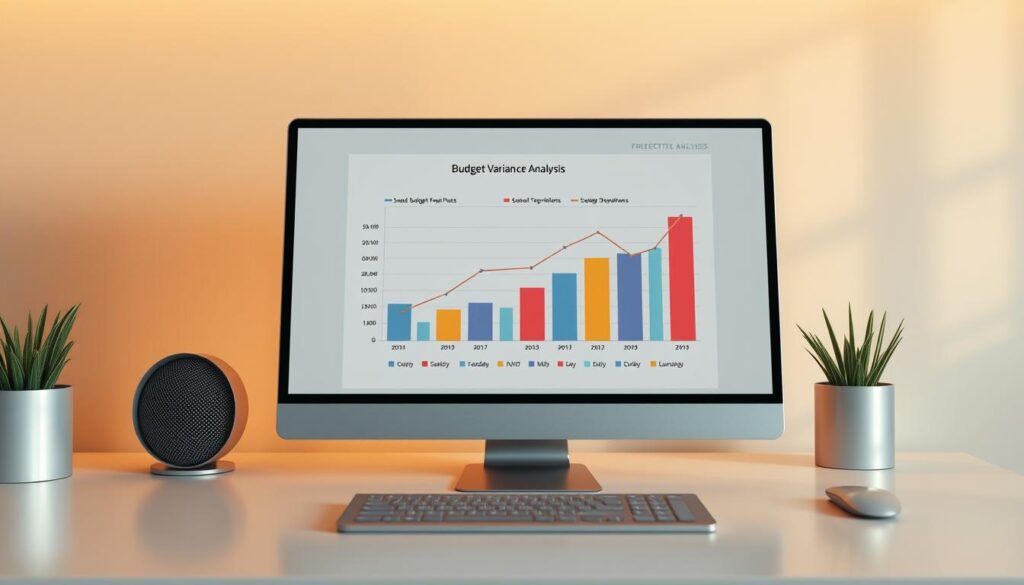In today’s fast-paced world, UK firms are always looking to improve their budgeting. Variance analysis in budgeting is a key tool. It helps spot differences between what was expected and what actually happened financially. By using financial variance analysis, UK firms can make their financial plans better, manage performance better, and have more control over money.
This article will explore the different sides of budget variance analysis. It will help UK firms use this important practice to get the best financial results.
Table of Contents
Key Takeaways
- Variance analysis identifies performance gaps for informed decision-making.
- Regular reviews can lead to improved budgeting accuracy and cost control.
- Favourable and unfavourable variances provide insights for strategic adjustments.
- Implementing technology can streamline the variance analysis process.
- It helps detect possible accounting errors and fraud indicators.
Understanding Variance Analysis in Budgeting
Variance analysis is key for UK companies to check their financial health. It shows the difference between what was expected and what actually happened. This helps understand if goals are being met.
For UK firms, variance analysis in budgeting spots any budgeting mistakes. It shows if a company is doing well financially and where it needs to improve. This information is very useful for finance teams to make better decisions.
Knowing about budget variance helps in making smart choices. It lets you fix problems before they get worse. Regular checks on variance analysis give managers the data they need for better planning and forecasting. This leads to better performance for the company.
Importance of Variance Analysis in Financial Management
Variance analysis is key in financial management. It gives valuable insights to decision makers. It helps understand budget performance by comparing planned and actual figures.
This analysis shows where things are not working well and points out trends that need action. It helps make smart choices.
Financial variance analysis in the UK lets you use real-time data. This helps your organisation change financial plans quickly. It makes managing resources better and improves forecasting.
This leads to a stronger financial position for your business. Regular budgeting variance analysis keeps you ahead. It helps your firm adjust to market changes and plan better.
How Variance Analysis Helps UK Firms
UK firms are using variance analysis in budgeting to improve their financial plans. This method helps them check how well they’re doing by looking at the difference between what they planned and what actually happened. It gives them the chance to see what’s working well and what needs work.
For instance, if a marketing effort does better than expected, it shows that sales are up. But if costs are higher than thought, or sales are down, it’s a sign that something needs to change. This way, companies can make their operations better, cut down on unnecessary spending, and stay true to their goals.
But variance analysis is more than just looking at numbers. It helps businesses make smart choices, leading to better financial health and staying competitive. By regularly checking your budget and spending, maybe with modern budget management software, you can avoid going over budget and make more accurate predictions.
In short, using variance analysis in budgeting is key for firms wanting to do better financially. This tool not only spots differences but also turns them into useful information that helps your business grow.
What is Budget Variance Analysis?
Budget variance analysis is key for comparing what was budgeted against what actually happened. It lets you check how well your organisation is doing financially. In the UK, it involves looking closely at financial data like revenues, expenses, and profit margins.
This helps spot where things are going right and where they need work. By doing this analysis, you check if your budget guesses were right. This is important for making better budgets in the future.
Knowing about different variances, like revenue or cost variances, helps you manage money better. Each type of variance gives clues on how to fix problems and improve what’s working well.
For more on variance analysis, check out this useful resource.
| Type of Variance | Description |
|---|---|
| Revenue Variance | Difference between actual and budgeted revenue |
| Cost Variance | Difference between actual and budgeted costs including material, labour, and overhead variances |
| Profit Variance | Difference between actual and budgeted profit |
| Cash Flow Variance | Difference between actual and budgeted cash inflows and outflows |
Key Benefits of Variance Analysis in Budgeting
Using budgeting variance analysis can really help with managing money in your company. It shows how this method works and its benefits. It makes budgeting more accurate and helps spot important trends in performance.
Enhancing Budgeting Accuracy
Budgeting variance analysis is key in finding and fixing budgeting mistakes. It helps adjust forecasts to match real numbers. This makes financial planning more dependable over time.
About 70% of companies use spreadsheets for budgeting. Accurate analysis of these numbers is vital for making smart financial choices. This directly affects budget variance in UK companies.
Identifying Performance Trends
Regular variance analysis helps spot trends in your company’s performance. It shows which areas are doing well and which need work. This helps create focused plans to improve operations.
Seeing how budgeting affects financial outcomes is important. It helps keep your budgeting process flexible. Looking into monthly and quarterly budgeting can help improve financial management. For more tips, check out this guide on budgeting strategies.
The Process of Conducting Variance Analysis
Doing a variance analysis is a detailed process. It helps you check how well your budgeting is working. You can do this analysis at different times, like every month, quarter, or year. Each time you do it, you get to see different things about your budget.
Monthly, Quarterly, and Annual Variance Analysis
Checking your budget every month can show you problems right away. It helps you see if your money coming in and going out is changing. This lets you make quick changes if needed.
Looking at your budget every quarter gives you a bigger picture. You can see patterns and plan better for the future. And, checking your budget once a year shows you how you’ve done overall. It helps you find ways to get even better.
Identifying Adverse vs. Favorable Variances
It’s important to know the difference between good and bad variances. Bad variances mean you spent more than you thought or made less money than expected. These need your attention fast to avoid money problems.
Good variances mean you’re doing well with your budget or saving money. Finding these helps you keep getting better at budgeting. This makes your budgeting work even better over time.
Variance Analysis in Budgeting UK Firms
In the UK, budgeting variance is more than just following rules. It’s a key tool for improving financial health. Companies use it to find out where their budget and real spending differ. This helps them quickly adjust to market changes and stay financially disciplined.
Being able to spot and fix issues quickly is vital. It lets businesses meet their financial goals. Cloud-based budgeting tools help reduce mistakes in financial planning. Tools like QuickBooks, FreshBooks, or Xero make tracking expenses and reporting easier. This helps UK firms manage their money better.
The table below shows how using variance analysis with modern tools benefits UK firms:
| Budgeting Tool | Error Reduction (%) | Key Features |
|---|---|---|
| QuickBooks | Up to 90% | Real-time tracking, automated invoicing, detailed reports |
| FreshBooks | Up to 90% | Time tracking, expense reports, financial insights |
| Xero | Up to 90% | Bank feed integration, financial dashboard |
UK firms that focus on budget variance analysis make better decisions. They stay on track with their financial targets. For more on budgeting tools, check out this guide on the best budgeting.
Limitations of Variance Analysis
Variance analysis is key in financial management, helping with budget and financial variance analysis in the UK. Yet, it has some drawbacks that can affect your organisation’s performance.
Reactive Nature of Variance Analysis
This method often shows problems after they happen. This means you might just be fixing issues instead of stopping them before they start. It’s important to use forecasting alongside variance analysis to spot financial risks early.
Subjectivity in Data Interpretation
How analysts interpret variance data can differ a lot. This means different people might see different things in the same data. Some variances might be based on rules that don’t catch all problems. It’s vital to make sure everyone interprets data the same way.
Looking at many performance indicators helps deepen financial analysis. This method adds to variance analysis, giving a fuller view of your financial health.
| Aspect | Reactive Nature | Subjectivity |
|---|---|---|
| Implication | Delayed responses to financial issues | Inconsistent conclusions |
| Effect on Decision Making | Limits proactive strategies | Varied interpretations among analysts |
| Importance of Monitoring | Essential to mitigate risks | Critical for coherent reporting |
Integrating Variance Analysis in Strategic Decision Making
In today’s fast-changing business world, using variance analysis in strategic planning is key for UK firms. It helps move from just reacting to planning ahead, leading to better financial choices.
By using variance analysis in budgeting, UK firms can make smarter decisions on where to put resources and how to budget. This method also helps keep financial forecasts in line with company goals. For instance, financial variance analysis UK can spot areas needing quick fixes, helping to make timely changes.
When you start using variance analysis, you’ll understand how your business is doing better. You’ll see which parts are not doing well and where you can grow. This way, you can handle economic ups and downs and find new chances for growth.
Adding this analytical tool to your decision-making process boosts your whole organisation’s performance. It lets you find key insights through financial variance analysis UK. This supports creating winning strategies that work across different areas, promoting teamwork and sharing knowledge.
Role of Performance Reporting in Variance Analysis
Performance reporting is key in variance analysis. It gives stakeholders a full view of a company’s financial and operational success. It turns raw data from UK budget variance analysis into useful insights, helping understand performance trends.
Good performance reporting boosts transparency and accountability in an organisation. It makes variance analysis findings clear, leading to real strategy changes. For UK firms, strong performance reporting is essential for making smart decisions. This leads to better financial management and success in operations.
Transforming Data into Actionable Insights
Budget variance analysis is key for businesses wanting to make better decisions. It helps find the reasons behind budget differences and shows ways to grow. This way, companies can spot where they’re not doing well and where they can improve.
In the UK, using these insights makes budgeting more flexible and leads to better financial results. Advanced analytics and business intelligence tools help make sense of big data. This unlocks important trends and insights that guide business strategies.
Adding predictive analytics and machine learning to budget variance analysis gives a clearer view of the future. It helps companies make their strategies more effective. This way, they can quickly respond to market changes and what customers want.
Turning data into useful insights changes how companies manage their finances and work. For more detailed information and strategies, check out this resource.
Conclusion
Variance analysis is key for UK firms wanting to improve their budgeting and financial health. It helps spot differences between what was expected and what actually happened. This lets you make smart changes to your plans.
Using variance analysis in your budgeting can make your financial forecasts more accurate. As the business world changes, using financial variance analysis in the UK is more important than ever. It helps with growth and making good decisions.
Embracing variance analysis is not just about numbers; it helps you make choices that match your financial goals. As you face market challenges, using these insights will help your business succeed.
FAQ
What is variance analysis in budgeting?
Variance analysis in budgeting is about checking the difference between what was expected and what really happened. It helps organisations see if they are meeting their financial goals. This is done by comparing what was forecasted with what actually happened.
Why is variance analysis important for UK firms?
For UK firms, variance analysis is key. It shows how well they are doing financially and points out any issues. This helps them improve their financial plans and budget better.
How do UK companies conduct budget variance analysis?
UK companies compare their budgeted numbers with what actually happened. They look at things like income and expenses. This helps them check their budgeting and make any needed changes.
What are some key benefits of using variance analysis?
Using variance analysis helps improve budgeting and spot trends. It also helps make better decisions. By finding and fixing issues, companies can work more efficiently and use their resources better.
What are the limitations of variance analysis?
Variance analysis is useful but has its limits. It mainly reacts to problems after they happen. It can also be open to interpretation, leading to different views on the same data. This might miss important financial issues.
How can variance analysis be integrated into strategic decision-making?
Variance analysis helps in making strategic decisions by providing useful insights. These insights guide how resources are allocated and financial plans are made. This ensures decisions support the company’s overall strategy.
What role does performance reporting play in variance analysis?
Performance reporting works alongside variance analysis to give a clear picture of a company’s performance. It shows how well the company is doing against its targets. This helps in making informed decisions based on the analysis.











